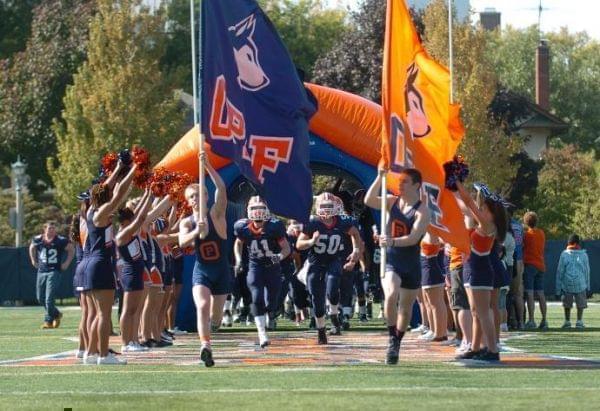Property Tax Relief Measure Has A Few Wrinkles

A property tax relief provision added to Illinois' school funding law during final negotiations includes grants for a few districts that already have adequate funding, such as Oak Park River Forest High School. Oak Park-River Forest High School
More than two dozen school districts learned last week that they're eligible for property tax relief grants from the Illinois State Board of Education. Most of those districts have inadequate funding. But a few already exceed what's needed to provide a good education.
That irony could be a consequence of how the grants were created, back in the summer of 2017.
Illinois has long relied on local property taxes to fund public education, forcing some districts with low property values to put the squeeze on homeowners. The new school funding reform law passed in August of 2017 tackled that problem by channeling more state funds to the neediest districts. But two big items were added near the end of negotiations, to garner bipartisan support: A tax-credit scholarship program for private schools, and a property tax relief provision. Neither idea was aired in any public debate.
The private school tax credit provision has proved popular among Chicago families, although Gov. J.B. Pritzker has called it a bad idea and indicated he may allow the program to sunset.
The property tax relief plan took longer to roll out. The provision acts as an incentive for districts to lower their taxes by promising $50 million worth of tax relief grants. ISBE — the same agency that calculates school funding — is also tasked with calculating these grants. More than 370 of Illinois’ 852 school districts applied for the tax relief grants. To qualify, a district has to have a tax rate significantly higher than other similar districts.
Last week, ISBE notified 28 districts that they’re eligible for grants. But they don’t get the money right away. Before eligible school districts can receive the grants, they must prove that they have actually lowered taxes for one year. ISBE will then disburse the grants at a percentage inversely linked to each district’s level of funding adequacy. That means, for example, that Ohio Community High School District 505, which applied for more than $100,000 in tax relief, is eligible to receive just about $20,000, because it’s already operating at about 90 percent of adequate funding.
But some educators are questioning why such a comfortable district is eligible to receive even more state funds. Mike Jacoby, director of the Illinois Association of School Business Officials, is one of the chief architects of the school funding reform plan, and he says the fact that Ohio and other well-funded districts are eligible for this grant suggests the tax relief formula needs more discussion.
“I understand the motivation for property tax relief, but I do believe we need to look at a linkage to percentage of adequacy,” he says. “For districts that are already highly-funded, they probably don’t need a property tax relief grant to give relief to their citizenry, and that takes dollars away from the other districts that have a long way to go before they have adequate resources for all their children.”
Once awarded, these grants become part of a district’s annual state aid, even though nothing in the provision requires the district to continue the lower tax rate in subsequent years. However, the funds count in a district’s adequacy calculation, which could affect the amount of state aid the district would receive through the new evidence-based funding model.
One district that qualifies for tax relief is Oak Park River Forest School District 200, which happens to be the home of both Tony Smith, the outgoing state superintendent of schools, and Michelle Turner Mangan, who chairs the professional review panel in charge of recalibrating the school funding model.
Jackie Matthews, spokeswoman for the state board, said in an email that the agency had no control over which districts were eligible.
“The grant opportunity was open to all school districts. A total of 373 districts applied this year. The State Board of Education has no discretion in administering the grant. We perform the calculations exactly as they are prescribed in statute. The formula in the law awards eligibility to those districts with the highest unit equivalent tax rate compared to all the districts that applied,” she wrote.
The calculations are posted publicly on ISBE’s website at isbe.net/proptaxrelief.
More information about the process is available here.
Links
- Audit Dings Rauner Administration For Lost Property, Vacant Appointments
- Rauner Pushes For Long-Term Property-Tax Freeze, But Not all Republicans Agree
- While Champaign Schools Wait For State Money, Property Taxes Keep Buses Moving, Staff In Place
- Lawmakers Consider More Property Tax Breaks For Seniors
- Illinois Issues: The Real Chilling Effect Of A Property Tax Freeze
- Illinois Lawmakers Split Over Property Taxes

